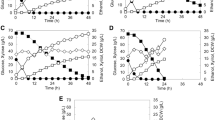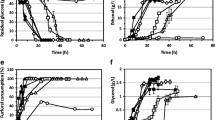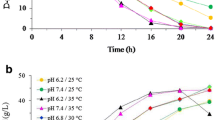Abstract
Redox potential was used to develop a stationary-phase fermentation of Candida tropicalis that resulted in non-growth conditions with a limited decline in cell viability, a xylitol yield of 0.87 g g−1 (95% of the theoretical value), and a high maximum specific production rate (0.67 g g−1 h−1). A redox potential of 100 mV was found to be optimum for xylitol production over the range 0–150 mV. A shift from ethanol to xylitol production occurred when the redox potential was reduced from 50 mV to 100 mV as cumulative ethanol (Y ethanol) decreased from 0.34 g g−1 to 0.025 g g−1 and Y xylitol increased from 0.15 g g−1 to 0.87 g g−1 (α=0.05). Reducing the redox potential to 150 mV did not improve the fermentation. Instead, the xylitol yield and productivity decreased to 0.63 g g−1 and 0.58 g g−1 h−1 respectively and cell viability declined. The viable, stationary-phase fermentation could be used to develop a continuous fermentation process, significantly increasing volumetric productivity and reducing downstream separation costs, potentially by the use of a membrane cell-recycle reactor.




Similar content being viewed by others
References
Barbosa MFS, Medeiros MB, Mancilha IM de, Schneider H, Lee H (1988) Screening for yeasts for production xylitol from some factors which affect xylitol yield in Candida guillermondi. J Ind Microbiol 3:241–251
Berovic M (1999) Scale-up of citric acid fermentation by redox potential control. Biotechnol Bioeng 64:552–557
Bruinenburg PM, Bot PHM de, Dijken JP van, Scheffers, WA (1983) The role of redox balances in the anaerobic fermentation of xylose by yeasts. Appl Microbiol Biotechnol 18:287–292
Choi J-H, Moon K-H, Ryu Y-W, Seo J-H (2000) Production of xylitol in cell recycle fermentations of Candida tropicalis. Biotechnol Lett 22:1625–1628
Chung IS, Lee YY (1986) Effect of oxygen and redox potential on d-xylose fermentation by non-growing cells of Pachysolen tannophilus. Enzyme Microb Technol 8:503–507
Hashimoto SI, Katsumata R (1999) Mechanism of alanine hyperproduction by Arthrobacter oxydans HAP-1: metabolic shift to fermentation under nongrowth aerobic conditions. Appl Environ Microbiol 65:2781–2783
Kastner JR, Roberts RS (1990) Simultaneous fermentation of d-xylose and glucose by Candida shehatae. Biotechnol Lett 12:57–60
Kastner JR, Ahmad M, Jones WJ, Roberts RS (1992) Viability of Candida shehatae in d-xylose fermentations with added ethanol. Biotechnol Bioeng 40:1282–1285
Kastner JR, Roberts RS, Jones WJ (1999) Oxygen starvation induces cell death in d-xylose Candida shehatae fermentations, but not in glucose. Appl Microbiol Biotechnol 51:780–783
Kastner JR, Eiteman MA, Lee SA. (2001) Glucose repression of xylitol production in Candida tropicalis mixed-sugar fermentations. Biotechnol Lett 23:1663–1668
Kim EK, Roberts RS (1991) Rate equations for the vigorous stationary phase fermentation of citric acid by Saccharomyces lipolytica. Biotechnol Bioeng 37:985–988
Kim JH, Ryu YW, Seo JH (1999) Analysis and optimization of a two-substrate fermentation for xylitol production using Candida tropicalis. J Ind Microbiol Biotechnol 22:181–186
Kim JH, Han KC, Koh YH, Ryu YW, Seo JH (2002) Optimization of fed-batch fermentation for xylitol production Candida tropicalis. J Ind Microbiol Biotechnol 29:16–19
Oh DK, Kim SY (1998) Increase of xylitol yield by feeding xylose and glucose in Candida tropicalis. Appl Microbiol Biotechnol 50:419–425
Oh DK, Kim SY, Kim JH (1998) Increase of xylitol production rate by controlling redox potential in Candida parapsilosis. Biotechnol Bioeng 58:440–444
Radjai MK, Hatch RT, Cadman TW (1984) Optimisation of amino acid production by automatic self tuning digital control of redox potential. Biotechnol Bioeng Symp 14: 657–666
Rose AH, Harrison JS (1989) Metabolism and physiology of yeasts. (The yeasts, vol 3) Academic Press, New York
Schneider H (1989) Conversion of pentoses to ethanol by yeasts and fungi. Crit Rev Biotechnol 9:2–41
Shi NQ, Jeffries TW (1998) Anaerobic growth and improved fermentation of Pichia stipitis bearing a URA1 gene from Saccharomyces cerevisiae. Appl Microbiol Biotechnol 50:339–345
Von Weymarn N, Kiviharju K, Leisola M (2002) High-level production of d-mannitol with membrane cell-recycle bioreactor. J Ind Microbiol Biotechnol 29:44–49
Walton AZ, Stewart JD (2002) An Efficient enzymatic baeyer-villiger oxidation by engineered Escherichia coli cells under non-growing conditions. Biotechnol Prog 18:262–268
Acknowledgements
This research was supported through the Traditional Industries, FoodPac Program (State of Georgia, USA).
Author information
Authors and Affiliations
Corresponding author
Additional information
An erratum to this article can be found at http://dx.doi.org/10.1007/s00253-004-1583-9
Rights and permissions
About this article
Cite this article
Kastner, J.R., Eiteman, M.A. & Lee, S.A. Effect of redox potential on stationary-phase xylitol fermentations using Candida tropicalis . Appl Microbiol Biotechnol 63, 96–100 (2003). https://doi.org/10.1007/s00253-003-1320-9
Received:
Revised:
Accepted:
Published:
Issue Date:
DOI: https://doi.org/10.1007/s00253-003-1320-9




